英语定语从句
- 格式:doc
- 大小:100.00 KB
- 文档页数:16
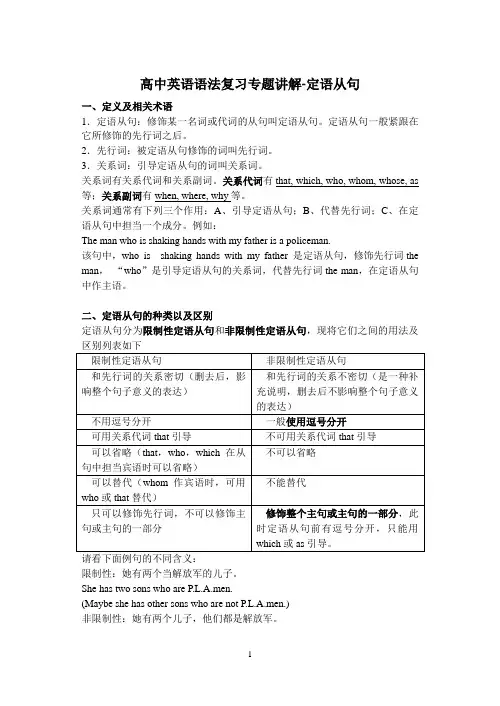
高中英语语法复习专题讲解-定语从句一、定义及相关术语1.定语从句:修饰某一名词或代词的从句叫定语从句。
定语从句一般紧跟在它所修饰的先行词之后。
2.先行词:被定语从句修饰的词叫先行词。
3.关系词:引导定语从句的词叫关系词。
关系词有关系代词和关系副词。
关系代词有that, which, who, whom, whose, as 等;关系副词有when, where, why等。
关系词通常有下列三个作用:A、引导定语从句;B、代替先行词;C、在定语从句中担当一个成分。
例如:The man who is shaking hands with my father is a policeman.该句中,who is shaking hands with my father 是定语从句,修饰先行词the man,“who”是引导定语从句的关系词,代替先行词the man,在定语从句中作主语。
二、定语从句的种类以及区别定语从句分为限制性定语从句和非限制性定语从句,现将它们之间的用法及区别列表如下限制性:她有两个当解放军的儿子。
She has two sons who are P.L.A.men.(Maybe she has other sons who are not P.L.A.men.)非限制性:她有两个儿子,他们都是解放军。
She has two sons,who are P.L.A.men.(She has only two sons.They are both P.L.A.men.)三、关系代词的用法区分1.修饰物体时关系代词that和 which的区分•只能使用that的情况:(1)当先行词即有人又有物时。
eg. I won’t forget the things and the persons that I saw.(2)当先行词被形容词最高级、序数词所修饰时。
eg. This is the first book that I bought myself.The biggest bird that I caught is this bird.(3)当先行词所在句子含疑问词who,which时。
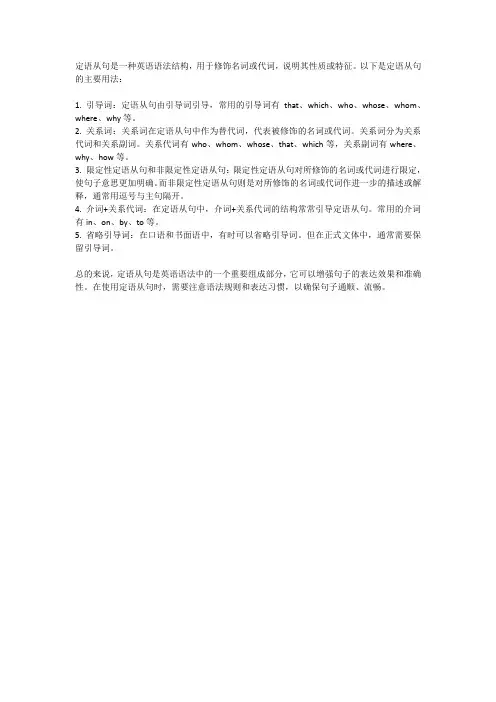
定语从句是一种英语语法结构,用于修饰名词或代词,说明其性质或特征。
以下是定语从句的主要用法:
1. 引导词:定语从句由引导词引导,常用的引导词有that、which、who、whose、whom、where、why等。
2. 关系词:关系词在定语从句中作为替代词,代表被修饰的名词或代词。
关系词分为关系代词和关系副词。
关系代词有who、whom、whose、that、which等,关系副词有where、why、how等。
3. 限定性定语从句和非限定性定语从句:限定性定语从句对所修饰的名词或代词进行限定,使句子意思更加明确。
而非限定性定语从句则是对所修饰的名词或代词作进一步的描述或解释,通常用逗号与主句隔开。
4. 介词+关系代词:在定语从句中,介词+关系代词的结构常常引导定语从句。
常用的介词有in、on、by、to等。
5. 省略引导词:在口语和书面语中,有时可以省略引导词。
但在正式文体中,通常需要保留引导词。
总的来说,定语从句是英语语法中的一个重要组成部分,它可以增强句子的表达效果和准确性。
在使用定语从句时,需要注意语法规则和表达习惯,以确保句子通顺、流畅。
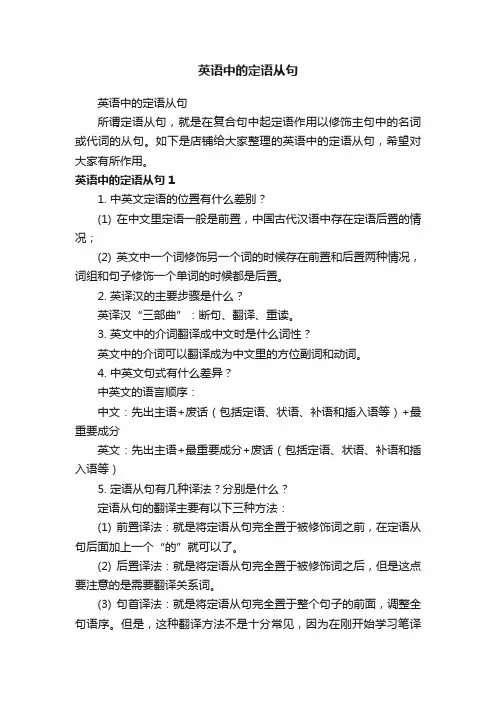
英语中的定语从句英语中的定语从句所谓定语从句,就是在复合句中起定语作用以修饰主句中的名词或代词的从句。
如下是店铺给大家整理的英语中的定语从句,希望对大家有所作用。
英语中的定语从句11. 中英文定语的位置有什么差别?(1) 在中文里定语一般是前置,中国古代汉语中存在定语后置的情况;(2) 英文中一个词修饰另一个词的时候存在前置和后置两种情况,词组和句子修饰一个单词的时候都是后置。
2. 英译汉的主要步骤是什么?英译汉“三部曲”:断句、翻译、重读。
3. 英文中的介词翻译成中文时是什么词性?英文中的介词可以翻译成为中文里的方位副词和动词。
4. 中英文句式有什么差异?中英文的语言顺序:中文:先出主语+废话(包括定语、状语、补语和插入语等)+最重要成分英文:先出主语+最重要成分+废话(包括定语、状语、补语和插入语等)5. 定语从句有几种译法?分别是什么?定语从句的翻译主要有以下三种方法:(1) 前置译法:就是将定语从句完全置于被修饰词之前,在定语从句后面加上一个“的”就可以了。
(2) 后置译法:就是将定语从句完全置于被修饰词之后,但是这点要注意的是需要翻译关系词。
(3) 句首译法:就是将定语从句完全置于整个句子的前面,调整全句语序。
但是,这种翻译方法不是十分常见,因为在刚开始学习笔译的时候,我们不主张改变句子结构,不然很容易引起句子的歧义。
6. 循环套用定语从句是什么?怎么进行翻译?每一个定语从句都是在修饰前一个定语从句中的`最后一个名词,这样就形成了一种循环的状态,我们把这样的定语从句称之为“循环套用”定语从句。
结构如下:中心词+定语1+定语2+定语3+……定语N翻译公式:定语1+定语2≈定语3 就把前两者放在一起翻译定语1≈定语2+定语3 就把后两者放在一起翻译如果三个定语一样长,根据经验判断还是把前两个放在一起翻译。
7. 需要断句的长句和不需要断句的长句分别怎样进行翻译?(1) 第一种,长句不带有很多标点,句子结构比较复杂,要先断句,再翻译,最后就是重读;(2) 第二种,长句带有很多逗号,首先还是先断句,看看有没有什么不明白的地方。
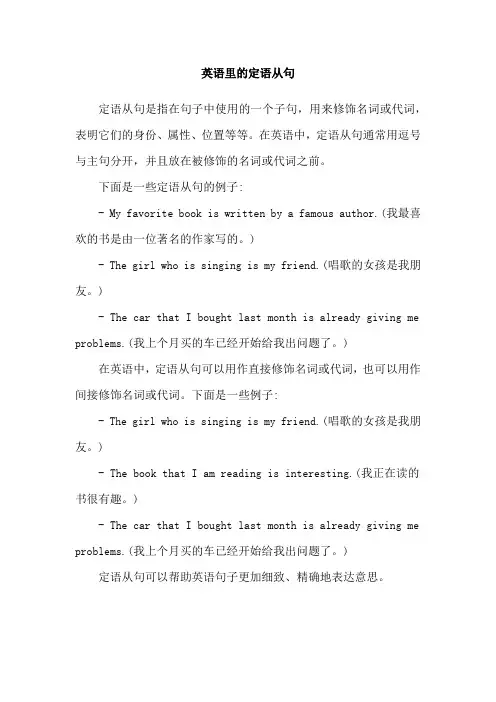
英语里的定语从句
定语从句是指在句子中使用的一个子句,用来修饰名词或代词,表明它们的身份、属性、位置等等。
在英语中,定语从句通常用逗号与主句分开,并且放在被修饰的名词或代词之前。
下面是一些定语从句的例子:
- My favorite book is written by a famous author.(我最喜欢的书是由一位著名的作家写的。
)
- The girl who is singing is my friend.(唱歌的女孩是我朋友。
)
- The car that I bought last month is already giving me problems.(我上个月买的车已经开始给我出问题了。
)
在英语中,定语从句可以用作直接修饰名词或代词,也可以用作间接修饰名词或代词。
下面是一些例子:
- The girl who is singing is my friend.(唱歌的女孩是我朋友。
)
- The book that I am reading is interesting.(我正在读的书很有趣。
)
- The car that I bought last month is already giving me problems.(我上个月买的车已经开始给我出问题了。
)
定语从句可以帮助英语句子更加细致、精确地表达意思。
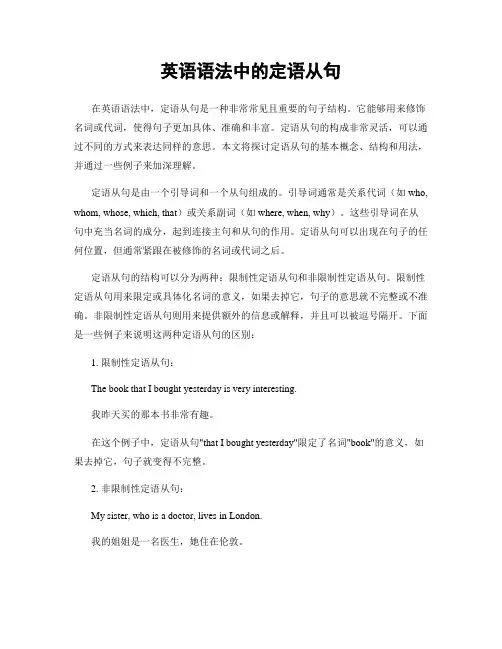
英语语法中的定语从句在英语语法中,定语从句是一种非常常见且重要的句子结构。
它能够用来修饰名词或代词,使得句子更加具体、准确和丰富。
定语从句的构成非常灵活,可以通过不同的方式来表达同样的意思。
本文将探讨定语从句的基本概念、结构和用法,并通过一些例子来加深理解。
定语从句是由一个引导词和一个从句组成的。
引导词通常是关系代词(如who, whom, whose, which, that)或关系副词(如where, when, why)。
这些引导词在从句中充当名词的成分,起到连接主句和从句的作用。
定语从句可以出现在句子的任何位置,但通常紧跟在被修饰的名词或代词之后。
定语从句的结构可以分为两种:限制性定语从句和非限制性定语从句。
限制性定语从句用来限定或具体化名词的意义,如果去掉它,句子的意思就不完整或不准确。
非限制性定语从句则用来提供额外的信息或解释,并且可以被逗号隔开。
下面是一些例子来说明这两种定语从句的区别:1. 限制性定语从句:The book that I bought yesterday is very interesting.我昨天买的那本书非常有趣。
在这个例子中,定语从句"that I bought yesterday"限定了名词"book"的意义,如果去掉它,句子就变得不完整。
2. 非限制性定语从句:My sister, who is a doctor, lives in London.我的姐姐是一名医生,她住在伦敦。
这个例子中的定语从句"who is a doctor"提供了关于"my sister"的额外信息,并且可以被逗号隔开。
除了限制性和非限制性定语从句,还有其他一些特殊的定语从句形式。
例如,我们可以使用关系代词"whose"来表示所属关系,或者使用关系副词"where"来表示地点,"when"来表示时间,"why"来表示原因。
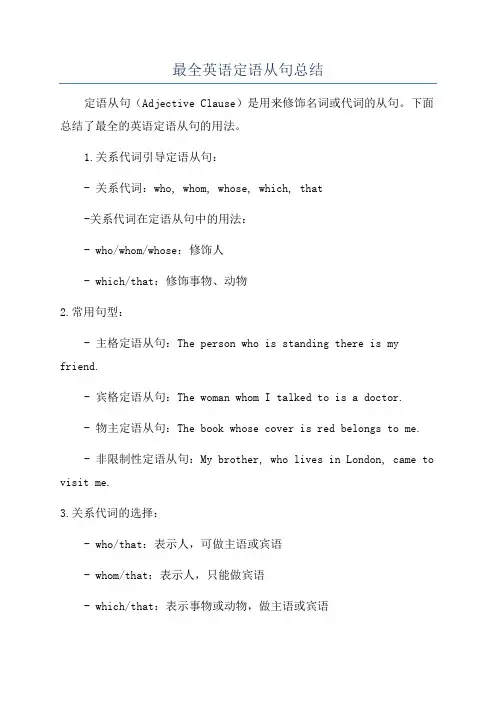
最全英语定语从句总结定语从句(Adjective Clause)是用来修饰名词或代词的从句。
下面总结了最全的英语定语从句的用法。
1.关系代词引导定语从句:- 关系代词:who, whom, whose, which, that-关系代词在定语从句中的用法:- who/whom/whose:修饰人- which/that:修饰事物、动物2.常用句型:- 主格定语从句:The person who is standing there is my friend.- 宾格定语从句:The woman whom I talked to is a doctor.- 物主定语从句:The book whose cover is red belongs to me.- 非限制性定语从句:My brother, who lives in London, came to visit me.3.关系代词的选择:- who/that:表示人,可做主语或宾语- whom/that:表示人,只能做宾语- which/that:表示事物或动物,做主语或宾语- whose:表示物或人,表示所有关系4.关系副词引导定语从句:- 关系副词:where, when, why-关系副词在定语从句中的用法:- where:表示地点- when:表示时间- why:表示原因5.非限制性定语从句:-非限制性定语从句用逗号与句子主体隔开,几乎与主句无关,可以省略-非限制性定语从句对句子的主要内容起补充或解释作用- 非限制性定语从句中常用关系代词who, which, that 或者关系副词when6.定语从句省略:- 在定语从句中,如果从句主语和主句的主语相同并且是人称代词,可以省略关系代词who/whom/which/that7.定语从句中的动词形式:-定语从句中的谓语动词根据先行词的人称和数的特点进行变化,但受关系代词引导的从句不存在时态变化总之,定语从句是修饰名词或代词的从句,可以由关系代词或关系副词引导。
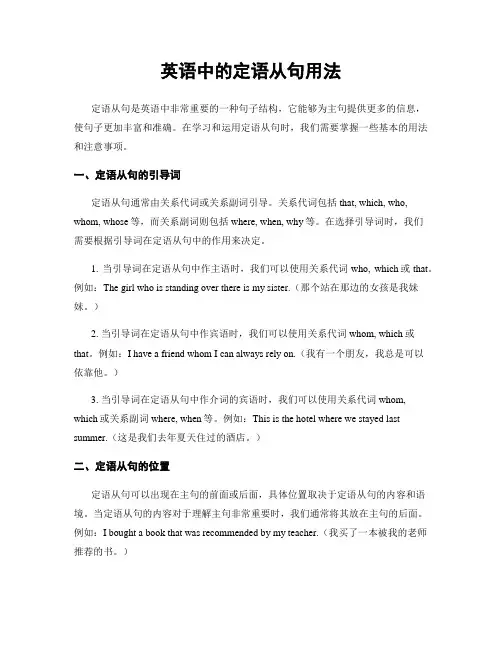
英语中的定语从句用法定语从句是英语中非常重要的一种句子结构,它能够为主句提供更多的信息,使句子更加丰富和准确。
在学习和运用定语从句时,我们需要掌握一些基本的用法和注意事项。
一、定语从句的引导词定语从句通常由关系代词或关系副词引导。
关系代词包括that, which, who, whom, whose等,而关系副词则包括where, when, why等。
在选择引导词时,我们需要根据引导词在定语从句中的作用来决定。
1. 当引导词在定语从句中作主语时,我们可以使用关系代词who, which或that。
例如:The girl who is standing over there is my sister.(那个站在那边的女孩是我妹妹。
)2. 当引导词在定语从句中作宾语时,我们可以使用关系代词whom, which或that。
例如:I have a friend whom I can always rely on.(我有一个朋友,我总是可以依靠他。
)3. 当引导词在定语从句中作介词的宾语时,我们可以使用关系代词whom, which或关系副词where, when等。
例如:This is the hotel where we stayed last summer.(这是我们去年夏天住过的酒店。
)二、定语从句的位置定语从句可以出现在主句的前面或后面,具体位置取决于定语从句的内容和语境。
当定语从句的内容对于理解主句非常重要时,我们通常将其放在主句的后面。
例如:I bought a book that was recommended by my teacher.(我买了一本被我的老师推荐的书。
)另外,当定语从句的内容对于理解主句并不是非常重要时,我们通常将其放在主句的前面,并用逗号与主句隔开。
例如:The weather being fine, we decided to go for a picnic.(天气很好,我们决定去野餐。
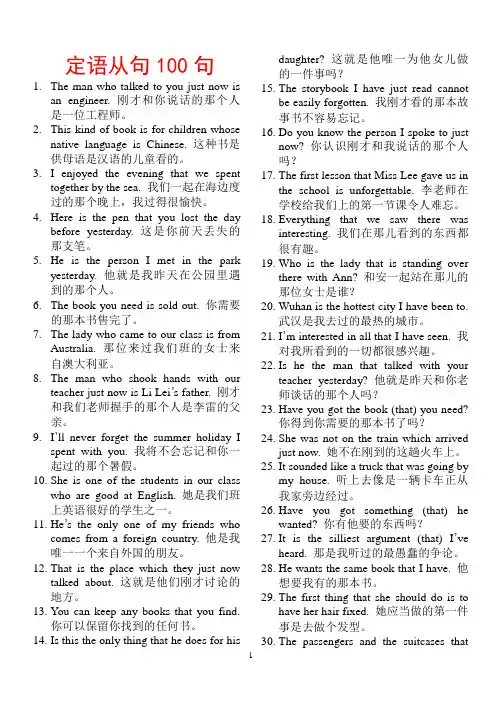
定语从句100句1.The man who talked to you just now isan engineer. 刚才和你说话的那个人是一位工程师。
2.This kind of book is for children whosenative language is Chinese. 这种书是供母语是汉语的儿童看的。
3.I enjoyed the evening that we spenttogether by the sea. 我们一起在海边度过的那个晚上,我过得很愉快。
4.Here is the pen that you lost the daybefore yesterday. 这是你前天丢失的那支笔。
5.He is the person I met in the parkyesterday. 他就是我昨天在公园里遇到的那个人。
6.The book you need is sold out. 你需要的那本书售完了。
7.The lady who came to our class is fromAustralia. 那位来过我们班的女士来自澳大利亚。
8.The man who shook hands with ourteacher just now is Li Lei’s father. 刚才和我们老师握手的那个人是李雷的父亲。
9.I’ll never forget the summer holiday Ispent with you. 我将不会忘记和你一起过的那个暑假。
10.She is one of the students in our classwho are good at English. 她是我们班上英语很好的学生之一。
11.He’s the only one of my friends whocomes from a foreign country. 他是我唯一一个来自外国的朋友。
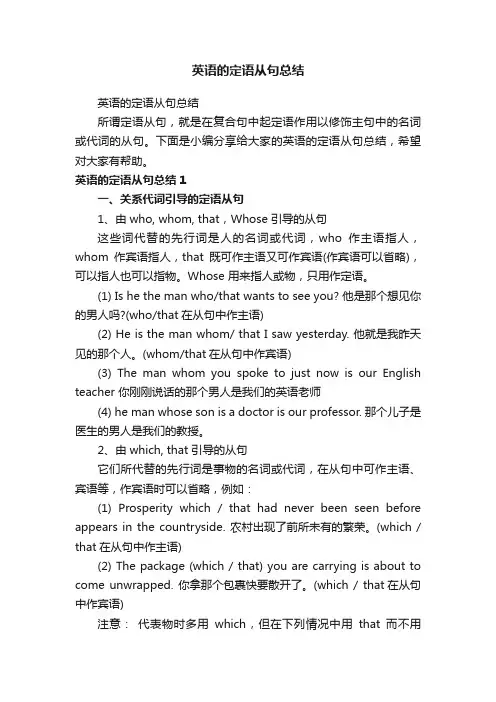
英语的定语从句总结英语的定语从句总结所谓定语从句,就是在复合句中起定语作用以修饰主句中的名词或代词的从句。
下面是小编分享给大家的英语的定语从句总结,希望对大家有帮助。
英语的定语从句总结1一、关系代词引导的定语从句1、由who, whom, that,Whose引导的从句这些词代替的先行词是人的名词或代词,who作主语指人,whom作宾语指人,that既可作主语又可作宾语(作宾语可以省略),可以指人也可以指物。
Whose 用来指人或物,只用作定语。
(1) Is he the man who/that wants to see you? 他是那个想见你的男人吗?(who/that在从句中作主语)(2) He is the man whom/ that I saw yesterday. 他就是我昨天见的那个人。
(whom/that在从句中作宾语)(3) The man whom you spoke to just now is our English teacher 你刚刚说话的那个男人是我们的英语老师(4) he man whose son is a doctor is our professor. 那个儿子是医生的男人是我们的教授。
2、由which, that引导的从句它们所代替的先行词是事物的名词或代词,在从句中可作主语、宾语等,作宾语时可以省略,例如:(1) Prosperity which / that had never been seen before appears in the countryside. 农村出现了前所未有的繁荣。
(which / that在从句中作主语)(2) The package (which / that) you are carrying is about to come unwrapped. 你拿那个包裹快要散开了。
(which / that在从句中作宾语)注意:代表物时多用which,但在下列情况中用that而不用which:a)先行词是anything, everything, nothing , none等不定代词时;b)先行词由every, any, all, some, no, little, few, much等修饰时,这时的that常被省略;c)先行词前有序数词或被形容词最高级修饰时;d)先行词中既有人又有物时;e)整个句中前面已有which,who,that时;f)当先行词为物并作表语时;g)先行词为one时;h)先行词同时又被the only,the very,the same修饰时;二、关系副词引导的定语从句1、when指时间在定语从句中做时间状语也可做连接词用I still remember the day when I first came to the school.2、where指地点在定语从句中做地点状语 Shanghai is the city where I was born.3、why指原因在定语从句中做原因状语,用在reason 后面。

英语语法定语从句1、定语从句的概念在复合句中,修饰某一名词或代词的从句叫定语从句。
被修饰的名词或代词叫先行词,引导定语从句的词叫关系词,定语从句一般放在先行词的后面。
2、定语从句的关系词引导定语从句的关系词有关系代词和关系副词,常见的关系代词包括that,which,who(宾格whom,所有格whose)等,关系副词包括where,when,why等。
关系代词和关系副词放在先行词及定语从句之间起连接作用,同时又作定语从句的重要成分。
3、定语从句的分类根据定语从句与先行词的关系,定语从句可分为限制性定语从句及非限制性定语从句。
限制性定语从句紧跟先行词,主句与从句不用逗号分开,从句不可省去。
非限制性定语从句与主句之间有逗号分开,起补充说明作用,如省去,意思仍完整。
4、关系代词的用法(1)that 既可以用于指人,也可以用于指物。
在从句中作主语、宾语或表语。
作主语时不可省略,作宾语可省略。
例如:Mary likes music that is quiet and gentle。
玛丽喜欢轻柔的音乐。
(that作主语)The coat (that) I put on the desk is blue。
我放在桌子上的那件外套是蓝色的。
(that作宾语)(2)which用于指物,在句中作主语、宾语或表语。
作主语不可省略,作宾语可省略。
例如:The building which stands near the train station is a supermarket。
位于火车站附近的那座大楼是一家超市。
(作主语)The film (which) we saw last night was wonderful。
我们昨天晚上看的那部电影很好看。
(作宾语)(3)who, whom用于指人,who 用作主语,whom用作宾语。
在口语中,有时可用who代替whom。
who和whom作宾语时也可省略。
例如:The girl who often helps me with my English is from England。

定语从句先行词指被定语从句修饰的名词、代词。
一般出现在定语从句的前面关系代词所代替的先行词是人或物的名词或代词,并在从句中充当主语、宾语、定语等成分。
关系代词在定语从句中作主语时,从句谓语动词的人称和数要和先行词保持一致。
作宾语时可省略。
I have an apple which is red. This is the place that(which) we visited last time.I have an apple that is green. He is still the boy that he was ten years ago.主句为完整的句子时大多用关系副词,WHEN WHERE WHY主句不完整时用关系代词代指人的有 who whom that代指物的有 which that 表…………的时用 whose1、who, which, that限定性定语从句中的关系代词可理解为必要从句。
The first English book that I read was "The Prince and the Pauper" by Mark Twain. 我读的第一本书是马克·吐温写的《王子与贫儿》。
(4)先行词既有人又有物时;He talked about the teachers and school that he visited. 他在讲他以前访问过的学校和老师。
(5)当主句是以who或which开始的特殊疑问句时,为避免重复用that;Who is the person that is standing at the gate? 那个站在门口的人是谁?(6)关系代词在从句中作表语时;He is not the man that he used to be. 他以前不是这样的人。
注:which在定语从句中指物,可作主语、及物动词或介词的宾语,作宾语时可省略;that在定语从句中既可指人又可指物,在定语从句中作主语、宾语或表语,作宾语时可省略。
英语中的定语从句一、定语从句的定义在英语中,定语从句是一种句子类型,其作用是修饰名词或代词,通常用来描述人或事物,或者说明某些特性或属性。
例如,在句子"The book that I borrowed from the library is very interesting"中,"that I borrowed from the library"就是一个定语从句,修饰了"the book"。
二、定语从句的作用定语从句的主要作用是限定名词或代词的含义,补充更多信息,使其更具描述性。
例如,"The book that I borrowed from the library"这句话中,"that I borrowed from the library"提供了关于这本书的更多信息,使读者能够更清楚地了解这本书的特点。
三、定语从句的构成定语从句通常由关系代词(如that、which、who等)或关系副词(如where、when、why等)引导。
关系代词或关系副词在定语从句中起到连接主句和从句的作用,同时表示从句和主句之间的关系。
例如,"The book that I borrowed from the library"中的"that"就是关系代词,它引导了定语从句,表示这本书是我从图书馆借的。
四、关系代词的用法关系代词通常用于引导定语从句,并在从句中充当主语或宾语。
它们主要有以下几种形式:1. that:通常用于引导限制性定语从句,修饰人或物。
2. which:通常用于引导非限制性定语从句,修饰事物。
3. who:通常用于引导限制性定语从句,修饰人。
4. whom:通常用于引导非限制性定语从句,修饰人或物。
例如,"The book that I borrowed from the library"中的"that"就是关系代词,它在从句中充当主语。
英语语法大全定语从句18. 定语从句定语从句(Attributive Clauses)在句中做定语,修饰一个名词或代词,被修饰的名词,词组或代词即先行词。
定语从句通常出现在先行词之后,由关系词(关系代词或关系副词)引出。
关系代词有:who, whom, whose, that, which等。
关系副词有:when, where, why等。
18.1 关系代词引导的定语从句关系代词所代替的先行词是人或物的名词或代词,并在句中充当主语、宾语、定语等成分。
关系代词在定语从句中作主语时,从句谓语动词的人称和数要和先行词保持一致。
1)who, whom, that这些词代替的先行词是人的名词或代词,在从句中所起作用如下:Is he the man who/that wants to see you?他就是你想见的人吗?(who/that在从句中作主语)He is the man whom/ that I saw yesterday.他就是我昨天见的那个人。
(whom/that在从句中作宾语)2) Whose 用来指人或物,(只用作定语, 若指物,它还可以同of which互换), 例如:They rushed over to help the man whose car had broken down. 那人车坏了,大家都跑过去帮忙。
Please pass me the book whose (of which) cover is green. 请递给我那本绿皮的书。
3)which, that它们所代替的先行词是事物的名词或代词,在从句中可作主语、宾语等,例如:A prosperity which / that had never been seen before appears in the countryside. 农村出现了前所未有的繁荣。
(which / that在句中作宾语)The package (which / that) you are carrying is about to e unwrapped. 你拿的包快散了。
英语定语从句语法详解定语从句是英语中非常重要的一个语法结构,用于修饰名词或代词,并且在句子中起到定语的作用。
在本文中,我们将详细介绍英语定语从句的概念、用法以及常见的引导词。
一、定语从句的概念和用途定语从句是由一个句子作为整体,用来修饰名词或代词的句子。
它可以提供进一步的信息,使得句子更加具体明确。
定语从句通常放置在被修饰的名词或代词之后。
例如:The book that I bought yesterday is very interesting.我昨天买的那本书非常有趣。
In this sentence, "that I bought yesterday"是一个定语从句,修饰名词"book",进一步解释了这本书的情况。
二、引导定语从句的关系代词和关系副词定语从句通常由关系代词或关系副词引导。
常见的关系代词有:who、whom、whose、which、that等;常见的关系副词有:when、where、why等。
1. 关系代词的用法a. who/whom/whose:用于人。
who用作主语或宾语,whom用作宾语,而whose表示所有关系。
例如:The man who is standing over there is my father.那个站在那里的人是我爸爸。
The boy whom I met yesterday is my classmate.我昨天遇到的那个男孩是我的同学。
This is the house whose roof is red.这是一座屋顶是红色的房子。
b. which/that:用于物。
which用作主语或宾语,that可用作主语、宾语或定语。
例如:The car which/that is parked in front of the house is mine.停在房子前面的那辆车是我的。
The book which/that I borrowed from the library is very interesting.我从图书馆借来的那本书非常有趣。
英语里什么叫定语从句
定语从句:一个简单句跟在一名词或代词后(先行词)进展修饰限定,就叫做定语从句。
在主句中充当定语成分。
被修饰的词叫先行词。
定语从句不同于单词作定语的情况,它通常只能放在被修饰的词(即先行词)之后。
1)领先行词是序数词或被序数词、最高级,关系词用that。
2)领先行词既有人又有物时,用that。
3)领先行词带有the only,the very,the same,the last,the one等词时,用that。
4)当主句中有who或which时,为防止重复用that。
5)领先行词为something,anything,nothing,none,no,little,much,all等不定代词时用that。
1)如果先行词是
those,they,all,persons,people,he,anyone,one时用who 2)领先行词指人并含有较长的后置定语从句或在被分割的定语从句中时。
1)当主句先行词后有介词时,用which。
例:This is the one of which I'm speaking。
2)非限定性定语从句,用which。
3) 描述句中一般用which。
例:Beijing,which was China's capital for more than 800years。
4)those +复数名词之后,多用which .例:Shopkeeper want to keep a number of those goods which sell best。
5)先行词本身是that时,用which。
英语定语从句的用法在英语中有很多种句式,今天让大家一起了解英语中定语从句的用法、接下来小编在这里给大家带来英语定语从句的用法,我们一起来看看吧!英语定语从句的用法定语从句由关系代词who、whom、whose、which、what、as 和关系副词where、when、why等引导,但须记住:1.what不能引导定语从句.2.关系词的分析须考虑它在定语从句中的成分。
一.指人的关系代词有who、whose、whom、that. 试分析:The old man who/whom /that we visited yesterday is a famous artist.Miss Wang is taking care of the child whose parents have gone to Beijing .The man with whom my father shook hands just now is our headmaster.(=The man who/whom that my father shook hands with just now is our headmaster.)注:A. 指人时有时只用who不宜用that。
1.先行词为one、ones或anyone(1)The comrade I want to learn from is the one who studies hard and works hard.(2)Anyone who breaks the law should be punished.2.先行词为these时These who are going to Beijing are the best students of our school.3.在there be 开头的句子中There is a student who wants to see you.4.一个句子中带有两个定语从句,其中一个定语从句的关系代词是that,另一个宜用who,以免重复。
知识总结归纳(一)定语从句的结构:在复合句中,修饰某个名词或代词的句子(做这个名词或代词的定语)叫定语从句,定语从句一般放在被修饰的名词或代词后面,被修饰的名词或代词叫做定语从句的先行词,它与定语从句之间要有一个词连接,这个词指代先行词的内容叫做关系词(关系代词或关系副词:that, which, who, whose, when, where, why)。
先行词在定语从句中充当主语,宾语,时间,地点,原因状语。
结构:先行词+关系词+定语从句。
1. There she saw a wall of water that was quickly advancing towards her. 2. In Japan, someone who sees another person making the gesture will think it means money. 3. A theme park is a collection of rides, exhibitions or other attractions that are based on a common theme. 4. The park has a conservation center that helps protect marine animals and their habitats in the rivers and coastal waters of Asia.5. Visitors can go on exciting rides where they can feel what it is like to do the things they have seen their heroes do in the movie.6. Oprah Winfrey is a black woman whose rise to fame is an inspiring story.(二)定语从句分为限定性定语从句和非限定性定语从句:限定性定语从句:从句对先行词进行必要的描述或说明,缺少它,则句义显得不完整,从句与先行词紧密相连。
非限定性定语从句:对先行词进行补充说明,解释,它与先行词之间有逗号隔开。
1. Before she could move, she heard a loud noise, which grew to a terrible roar. 2. Tree after tree went down, cut down by the water, which must have been three meters deep. 3. Flora, whose beautiful hair and dress were all cold and wet, started crying. 4. Their talk includes rhythm and rhyming words as well as tongue twisters, which often make the audience applaud.(三)关系词前面可以根据定语从句的内容加上一些介词,这些关系词在介词后面常用which 或whom. 1. There was a man with whom I would have to work together and finally the manager of the company. 2. Many people who saw the film were afraid to swim in the sea when they remembered the scenes in which people were eaten by the shark.知识重点与难点(一)当先行词有最高级,序数词修饰,是不定代词,或是all, no, only等形式时,关系代词一般用that,而不能用which。
1. The Titanic was the largest ship that had ever been built at that time. 2. There is one thing that keeps worrying me.(二)当先行词是表示时间,地点,原因的词时,关系词用when, where, why 还有which, that 1. I’m very glad to return to my hometown where I had lived for 10 years. 2. This is my hometown which I used to talk about to you. 3. I think I can understand the reason why he didn’t tell the truth to me. 4. No one believes the reason that he gave us about his absence at the meeting.(三)定语从句的简化表达:1. The man who is sitting on the platform is a professor from Wuhan University.2. The letter that was mailed last night will reach him tomorrow.3. The question that is being discussed is very important.4. You are welcome to a party to be given in our class at 7:45. 说明:以上的定语从句部分可以用更加简单的非谓语形式表达出来:1. The man sitting on the platform is a professor from Wuhan University. 2. The letter mailed last night will reach him tomorrow. 3. The question beingdiscussed is very important. 4. You are welcome to a party to be given in our class at 7:45. 说明:修饰一个名词除了后面用定语从句以外,还可以用非谓语动词形式:doing短语,done短语,being done短语,to be done短语修饰。
其结构和意思如下:1. 被修饰名词+doing短语:正在做….的人/正在发生的事。
2. 被修饰名词+ done短语:被…..的人/事3. 被修饰名词+being done短语:正在被…..的人/事4. 被修饰名词+ to be done短语:将要被…..的人/事(1)Do you know the man talking to my sister ? (2)The “crazy”gesture, moving the index finger in a circle in front of the ear, means “you have a phone call”in Brazil. (3)Did you see that car being repaired ? (4)In a camera, the lens must be focused on the object to be photographed. (5)The students to attend the meeting will arrive here tomorrow. (6)Goods imported from abroad are not always better than those made in China. (7)The Yellow River, said to be “the mother river”runs across China like a huge dragon. 总结:以上做定语的那些短语就是英语语法中所说的分词,不定式的各种形式作定语。
1. 这些短语作定语应放在被修饰名词的后面。
如果单独一个V-ing或V-ed形式作定语,则可以放在被修饰名词前面。
2. 分词作定语时,其动作应与全句动作同时发生。
V-ing表示主动意义和正在做,V-ed表示被动意义。
being done表示正在被做的3. 不定式作定语表示将要发生的,to be done表示将要被做的【典型例题】[例1] Friendship is needed by all, _____ plays an important role in people’s lives.A. whichB. thatC. whoD. it分析:_____ plays an important role in people’s lives为非限定性定语从句修饰先行词Friendship用which连接定语从句。
答案:A[例2] Uncle Li _____ I worked three years ago has retired now.A. whoB. whomC. with whomD. to whom分析:_____ I worked three years ago作为定语从句修饰先行词Uncle Li,从句完整的表达是:I worked with Uncle Li three years ago. 所以关系词前应加上介词with。
答案:C[例3] Is this the reason _____ at the meeting for his carelessness in his work ?A. he explainedB. what he explainedC. how he explainedD. why he explained分析:定语从句_____ at the meeting for his carelessness in his work修饰先行词the reason指“他在会上就他工作中的粗心解释的原因。
先行词在从句中做宾语。
答案:A[例4] Teachers, _____ work is rather hard, are being better paid than before.A. whoB. thatC. whichD. whose分析:非限定性定语从句_____ work is rather hard修饰先行词teachers, 它与从句中的work 是从属关系,关系词用whose 答案:D[例5 ] The Olympic Games , _____ in 776 BC, didn’t included women players until 1912. A. first playing B. to be first played C. first played D.to be first playing 分析:公元前776年被首次举行的奥运会,直到1912年才容纳女运动员。